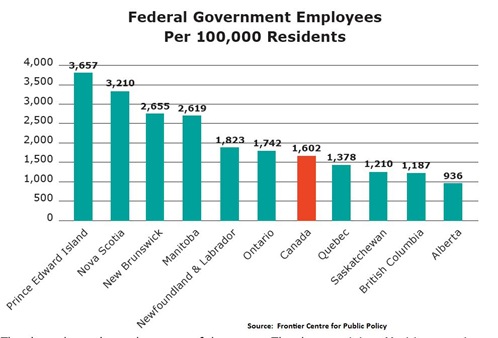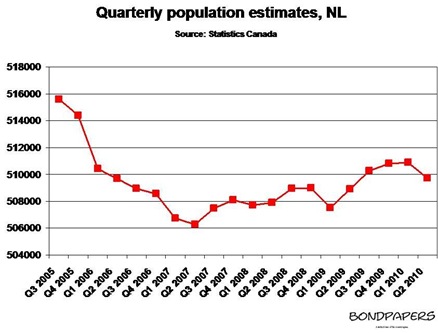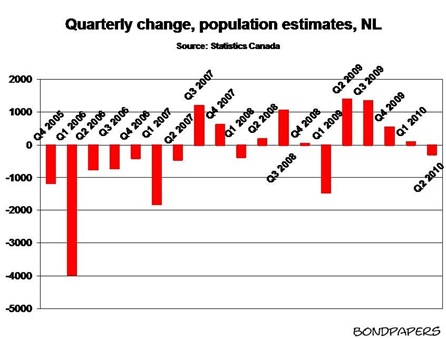“Obviously, I don't like to run deficits, but if I've got to fight a recession ... if we've got to get the economy booming again, then I'm not afraid to spend money and we're not afraid to lower taxes to stimulate the economy - that's good public policy.”
Finance minister Tom Marshall often speaks about one thing and does another. He’s famous for trotting out a debt clock during one budget consultation farce only to deliver a budget that did nothing to reduce debt.
This year Marshall has been trying to pass off deficit spending as if it was something new for this administration. It isn’t. They’ve run cash deficits in all but two years since 2004. If their current forecast holds, they will be adding a considerable amount of debt for the foreseeable future.
Adding debt is just staying the course for the Williams administration.
Premier Danny Williams himself has dismissed balanced budgets as meaningless. Marshall explicitly rejected any action like balanced budget legislation or having a debt reduction policy.
Marshall’s predecessor as finance minister - Loyola Sullivan - talked about balancing the books on a cash basis – he only did it once – and possibly not balancing the accrual books for a number of years. That was back in the early days of the administration when it looked like they were actually going to deal with some of the provincial government’s financial woes. But even for all that notice debt got within the first couple of years after Williams and the Tories took office, they were willing to rack up additional public debt.
Since we are discussing debt, let’s dispose of one of the finance minister’s more laughable claims from budget day:
“But we have cash to pay for that deficit. We will not increase our borrowing. Our debt will go up, but we don't have to borrow for that.”
On the face of it people may well wonder how you can increase public debt while not borrowing money.
The answer is pretty simple and it goes to the heart of the public debt charade Marshall and his colleagues have been foisting for the past few years.
Marshall covered the half billion shortfall in 2009 from temporary investments – extra cash – the provincial government had on hand. He didn’t have to go to the banks and negotiate a loan but he sure as heck borrowed the money: he borrowed it from taxpayers.
As for the debt, what he is referring to is net debt. Now for those who may not know, net debt is a calculation of what is owed compared to assets – cash, property and so on – that could theoretically be sold off to pay down the money that is owed.
Those temporary investments that the provincial government racked up over the past couple of years helped to make it look like the public debt had been paid down. That’s because they are exactly the sort of assets that would have bee used to figure out the net debt: liabilities less assets.
So when Tom took the cash and spent it, the net debt could only go back up. The net debt will go up again next year and the year after and any other year Tom winds up having to cover off over-spending.
Just remember, though, that the total liabilities haven’t changed much in the past few years. You can see that from a post last December on net debt and liabilities and in another post on net borrowings.
 This is not a subject the Fan Clubbers like to talk about but it is real. it also just happens to be one of the major financial problems facing the province that isn’t being addressed by the current administration.
This is not a subject the Fan Clubbers like to talk about but it is real. it also just happens to be one of the major financial problems facing the province that isn’t being addressed by the current administration.
Just to give you a sense of how much the past two budgets have followed what we could call the Williams administration debt addition policy, take a look at just the current account spending since 2003. That’s the money that pays the heat and light and delivers the services and salaries every day of every year.
And just to really keep it in perspective think of it this way. You can have a great net debt because you have a nice house, an expensive car and some jewels that could possibly be sold off if the bank called all your loans.
But since the house and the jewels don’t generate any cash each year they don’t help you pay the bills today. If you can’t afford food without whipping out the credit card you could be in a situation of being cash poor. Lots of nouveau riche business types are leveraged to the max. They drive flashy cars but they don’t really have a copper to their name. So without considering the cash deficit, the net debt could be a very misleading figure.
Anyway, take a gander at this table. It shows the percentage increase in current account spending every year from 2003 to the current budget.
| Fiscal Year | Percent increase from previous year |
| 2004 | Zero |
| 2005 | 5.3 |
| 2006 | 4.6 |
| 2007 | 8 |
| 2008 | 7.8 |
| 2009 | 10 |
| 2010 (forecast) | 7 |
That’s right.
Except for that first year, there’s never been a time when current account spending didn’t go up by at least twice the national rate of inflation. In some years spending shot up three and four times the rate of inflation.
This sort of spending is unsustainable.
This sort of financial state – all that spending coupled with all that untended debt – is unsustainable.
There are other consequences to the Williams administration economic policy, consequences that will become more obvious as this new series – The Fragile Economy – rolls out in the days ahead.
-srbp-



 This is not a subject the Fan Clubbers like to talk about but it is real. it also just happens to be one of the major financial problems facing the province that isn’t being addressed by the current administration.
This is not a subject the Fan Clubbers like to talk about but it is real. it also just happens to be one of the major financial problems facing the province that isn’t being addressed by the current administration.